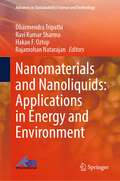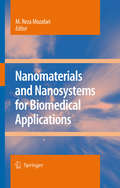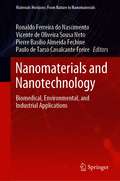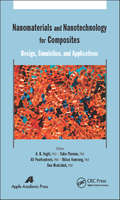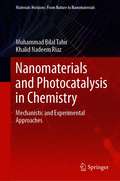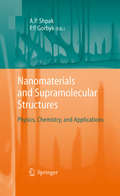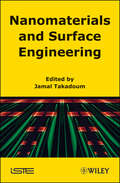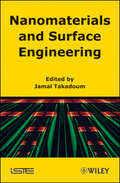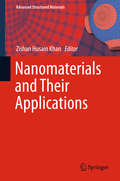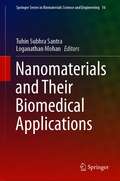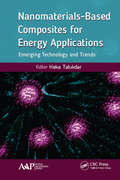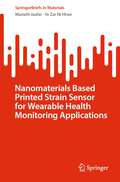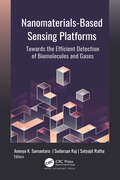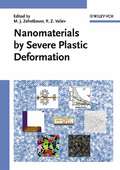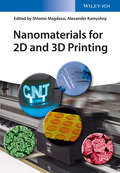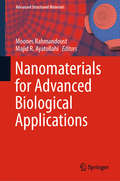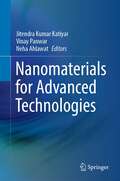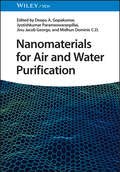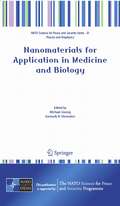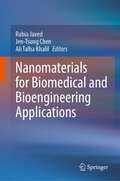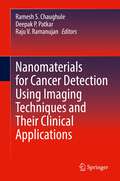- Table View
- List View
Nanomaterials and Nanoliquids: Applications in Energy and Environment (Advances in Sustainability Science and Technology)
by Dharmendra Tripathi Ravi Kumar Sharma Hakan F. Oztop Rajamohan NatarajanThis book discusses recent work on the use of nanoparticles in energy and environment-related work. This book presents experimental, numerical, analytical, and theoretical work on the use of nanomaterials in energy and environment. This book helps to highlight cutting-edge research and is a ready reference for the researchers working in this arena of academia and industries. This book provides insights related to various forms of nanotechnological applications in green buildings, environmental and electrochemical, solar distillation systems, green energy, storage tank of the SWH system, solar concentrator system's receiver, and CFD simulations of various aspects of nanofluids/hybrid nanofluids, which are particularly useful, valuable for the betterment of society.
Nanomaterials and Nanosystems for Biomedical Applications
by M. Reza MozafariUnder a single cover, this book brings together various aspects of functional bioengineered materials and nanostructured biomaterials including commonly used implants and sustained release nanodevices. The book includes expert reviews on the advances and current problems associated with the implants and nanodevices. Containing recent citations and bibliographies, this book will be an indispensable source of information for new researchers and scientists.
Nanomaterials and Nanotechnology: Biomedical, Environmental, and Industrial Applications (Materials Horizons: From Nature to Nanomaterials)
by Ronaldo Ferreira do Nascimento Vicente de Oliveira Sousa Neto Pierre Basílio Almeida Fechine Paulo de Tarso Cavalcante FreireThis book provides a complete overview of a wide range of nanomaterials from their synthesis and characterization to current and potential applications with special focus on the use of such nano-based products as functional agents in biomedical, environmental and industrial applications. It addresses the intrinsic relationship between aspects involving the synthesis of nanocompounds, their bio-physico-chemical properties and their interactions occurring in biomedical, environmental and industrial matrix. This book is of interest to engineers, academics and research scholars working in these fields.
Nanomaterials and Nanotechnology for Composites: Design, Simulation and Applications
by A. K. Haghi Sabu Thomas Ali Pourhashemi Abbas Hamrang Ewa KlodzinskaEngineered nanopolymer and nanoparticles, with their extraordinary mechanical and unique electronic properties, have garnered much attention in recent years. With a broad range of potential applications, including nanoelectronics, composites, chemical sensors, biosensors, microscopy, nanoelectromechanical systems, and many more, the scientific comm
Nanomaterials and Photocatalysis in Chemistry: Mechanistic and Experimental Approaches (Materials Horizons: From Nature to Nanomaterials)
by Muhammad Bilal Tahir Khalid Nadeem RiazThis book demonstrates the basic and fundamental aspects of nanotechnology and potential application as a photocatalysis in multiple application especially in environment and energy harvesting. This book also contains methods of preparation and characterization of unique nanostructured photocatalysts, and details about their catalytic action. The book consists of seven chapters, including the principles and fundamentals of heterogeneous photocatalysis; the mechanisms and dynamics of surface photocatalysis; research on pure and composites based materials with unique nanostructures; the latest developments and advances in exploiting photocatalyst alternatives to WO3; and photocatalytic materials for applications other than the traditional degradation of pollutants, such as carbon dioxide reduction, water oxidation, a complete spectrum of selective organic transformations and water splitting by photocatalytic reduction. This book will appeal to a wide readership of the academic and industrial researchers and it can also be used in the classroom for undergraduate and graduate students focusing on heterogeneous photocatalysis, sustainable chemistry, energy conversion and storage, nanotechnology, chemical engineering, environmental protection, optoelectronics, sensors, and surface and interface science.
Nanomaterials and Supramolecular Structures: Physics, Chemistry, and Applications
by Anatoliy Petrovych Shpak Petr Petrovych GorbykThe text features experimental investigations which use a variety of modern methods and theoretical modeling of surface structures and physicochemical processes which occur at solid surfaces. Nanomaterials and Supramolecular Structures: Physics, Chemistry, and Applications is intended for specialists experienced in the fields of Nanochemistry, Nanophysics, Surface Chemistry (and Physics), synthesis of new nanostructural functional materials and their practical applications. It will also prove useful to students, post-graduates, researchers, and lecturers.
Nanomaterials and Surface Engineering (Iste Ser.)
by Jamal TakadoumThis book covers a wide range of topics that address the main areas of interest to scientists, engineers, and students concerned with the synthesis, characterization and applications of nanomaterials. Development techniques, properties, and examples of industrial applications are all widely represented as they apply to various nanostructured materials including nanocomposites and multilayered nanometric coatings. It is recommended to anyone working in the field of nanomaterials, especially in connection with the functionalization and engineering of surfaces.
Nanomaterials and Surface Engineering
by Jamal TakadoumThis book covers a wide range of topics that address the main areas of interest to scientists, engineers, and students concerned with the synthesis, characterization and applications of nanomaterials. Development techniques, properties, and examples of industrial applications are all widely represented as they apply to various nanostructured materials including nanocomposites and multilayered nanometric coatings. It is recommended to anyone working in the field of nanomaterials, especially in connection with the functionalization and engineering of surfaces.
Nanomaterials and Their Applications (Advanced Structured Materials #84)
by Zishan Husain KhanThis book focuses on the latest advances in the field of nanomaterials and their applications, and provides a comprehensive overview of the state-of-the-art of research in this rapidly developing field. The book comprises chapters exploring various aspects of nanomaterials. Given the depth and breadth of coverage, the book offers a valuable guide for researchers and students working in the area of nanomaterials.
Nanomaterials and Their Biomedical Applications (Springer Series in Biomaterials Science and Engineering #16)
by Tuhin Subhra Santra Loganathan MohanThis book highlights the evolution of, and novel challenges currently facing, nanomaterials science, nanoengineering, and nanotechnology, and their applications and development in the biological and biomedical fields. It details different nanoscale and nanostructured materials syntheses, processing, characterization, and applications, and considers improvements that can be made in nanostructured materials with their different biomedical applications. The book also briefly covers the state of the art of different nanomaterials design, synthesis, fabrication and their potential biomedical applications. It will be particularly useful for reading and research purposes, especially for science and engineering students, academics, and industrial researchers.
Nanomaterials-Based Composites for Energy Applications: Emerging Technology and Trends
by Keka TalukdarThis volume, Nanomaterials-Based Composites for Energy Applications: Emerging Technology and Trends, covers the importance of nanomaterials-based composites for renewable and alternative energy applications. Taking a multidisciplinary approach, it looks at using composites without losing the extraordinary strength of the nanomaterials, preparing new composites with high dielectric permittivity, improving load-carrying capacity, and more. Simulation and experimental work is included, providing a current view of the research that is going on in laboratories all over the world. The book will be a rich reference for professors and instructors, professionals, researchers, and engineering students interested in applying the emerging field of nanoscience and nanotechnology to energy applications.
Nanomaterials-Based Composites for Energy Applications: Emerging Technology and Trends
by Keka TalukdarThis volume, Nanomaterials-Based Composites for Energy Applications: Emerging Technology and Trends, covers the importance of nanomaterials-based composites for renewable and alternative energy applications. Taking a multidisciplinary approach, it looks at using composites without losing the extraordinary strength of the nanomaterials, preparing new composites with high dielectric permittivity, improving load-carrying capacity, and more. Simulation and experimental work is included, providing a current view of the research that is going on in laboratories all over the world. The book will be a rich reference for professors and instructors, professionals, researchers, and engineering students interested in applying the emerging field of nanoscience and nanotechnology to energy applications.
Nanomaterials Based Printed Strain Sensor for Wearable Health Monitoring Applications (SpringerBriefs in Materials)
by Mariatti Jaafar Ye Zar Ni HtweThis book reviews different types of nanomaterials-based-conductive inks used to develop printed strain sensors, printing fabrication methods, and applications such as wearable health monitoring. Printed wearable electronic devices have recently drawn a lot of attention, as shown by the increasing number of publications and commercialized devices covering various facets in emerging fields. Many researchers are working toward optimizing nanoparticle-based-conductive inks for wearable electronics. However, issues related to its stability, dispersion, and annealing temperature often limit its applications. General important information and requirements of flexible electronics for health monitoring are covered in the book chapter. The target audiences are researchers and students who are involved in the development of printed wearable electronics.
Nanomaterials-Based Sensing Platforms: Towards the Efficient Detection of Biomolecules and Gases
by Aneeya K. Samantara, Sudarsan Raj and Satyajit RathaSensors are effective tools used to carry out cost-effective, fast, and reliable sensing for a wide range of applications. This volume presents a brief history behind sensing technology and highlights a broad range of biosensing techniques based on optical and electrochemical response methods. Starting from the traditional enzyme-based biosensing method to functionalized nanostructure-based sensors, this book also provides a detailed overview of some of the advanced sensing methodologies based on photonic crystal cavity-based sensing devices. The authors showcase the extraordinary success of nanomaterials, their current strategical exploitation, and an unprecedented pool of possibilities they hold for the future. Many of the technologies have been developed recently for the sensing of various bioanalytes and molecules, some of which have been included in this book through dedicated chapters. The book looks at various sensors, such as for biosensing, electrochemical sensing, gas sensing, photoelectrochemical sensing, and colorimetric sensing, all of which have shown vast potential.
Nanomaterials-Based Sensing Platforms: Towards the Efficient Detection of Biomolecules and Gases
by Aneeya K. Samantara Satyajit Ratha Sudarsan RajSensors are effective tools used to carry out cost-effective, fast, and reliable sensing for a wide range of applications. This volume presents a brief history behind sensing technology and highlights a broad range of biosensing techniques based on optical and electrochemical response methods. Starting from the traditional enzyme-based biosensing method to functionalized nanostructure-based sensors, this book also provides a detailed overview of some of the advanced sensing methodologies based on photonic crystal cavity-based sensing devices. The authors showcase the extraordinary success of nanomaterials, their current strategical exploitation, and an unprecedented pool of possibilities they hold for the future. Many of the technologies have been developed recently for the sensing of various bioanalytes and molecules, some of which have been included in this book through dedicated chapters. The book looks at various sensors, such as for biosensing, electrochemical sensing, gas sensing, photoelectrochemical sensing, and colorimetric sensing, all of which have shown vast potential.
Nanomaterials by Severe Plastic Deformation
by Michael J. Zehetbauer Ruslan Z. ValievThese proceedings of the "Second International Conference on Nanomaterials by Severe Plastic Deformation" review the enormous scientific avalanche that has been developing in the field over recent years. A valuable resource for any scientist and engineer working in this emerging field of nanotechnology.
Nanomaterials for 2D and 3D Printing
by Shlomo Magdassi Alexander KamyshnyThe first book to paint a complete picture of the challenges of processing functional nanomaterials for printed electronics devices, and additive manufacturing fabrication processes. Following an introduction to printed electronics, the book focuses on various functional nanomaterials available, including conducting, semi-conducting, dielectric, polymeric, ceramic and tailored nanomaterials. Subsequent sections cover the preparation and characterization of such materials along with their formulation and preparation as inkjet inks, as well as a selection of applications. These include printed interconnects, passive and active modules, as well as such high-tech devices as solar cells, transparent electrodes, displays, touch screens, sensors, RFID tags and 3D objects. The book concludes with a look at the future for printed nanomaterials. For all those working in the field of printed electronics, from entrants to specialized researchers, in a number of disciplines ranging from chemistry and materials science to engineering and manufacturing, in both academia and industry.
Nanomaterials for 2D and 3D Printing
by Shlomo Magdassi Yosi Shacham-DiamandThe first book to paint a complete picture of the challenges of processing functional nanomaterials for printed electronics devices, and additive manufacturing fabrication processes. Following an introduction to printed electronics, the book focuses on various functional nanomaterials available, including conducting, semi-conducting, dielectric, polymeric, ceramic and tailored nanomaterials. Subsequent sections cover the preparation and characterization of such materials along with their formulation and preparation as inkjet inks, as well as a selection of applications. These include printed interconnects, passive and active modules, as well as such high-tech devices as solar cells, transparent electrodes, displays, touch screens, sensors, RFID tags and 3D objects. The book concludes with a look at the future for printed nanomaterials. For all those working in the field of printed electronics, from entrants to specialized researchers, in a number of disciplines ranging from chemistry and materials science to engineering and manufacturing, in both academia and industry.
Nanomaterials for Advanced Biological Applications (Advanced Structured Materials #104)
by Moones Rahmandoust Majid R. AyatollahiThis book presents an overview of the ways in which the latest experimental and theoretical nanotechnologies are serving the fields of biotechnology, medicine, and biomaterials. They not only enhance the efficiency of common therapeutics and lower their risks, but thanks to their specific properties, they also provide new capabilities. Nano-scale measurement techniques, such as nano-indentation and nano-scratch methods, could potentially be used to characterize the physical and mechanical properties of both natural tissues and synthetic biomaterials in terms of strength and durability.
Nanomaterials for Advanced Technologies
by Jitendra Kumar Katiyar Vinay Panwar Neha AhlawatThis book presents experimental as well as simulation methodologies for analysis and development of nanostructures for introducing the desirable effects through modifications in the basic structure of select nanomaterials. The initial chapters in this book focus on exploring the basic aspects of nanomaterials, e.g., distinguishing features, synthesis, processing, characterization, simulation and application dimensions, or nanostructures that enable novel/enhanced properties or functions. The chapters also cover the size-dependent electronic, optical, and magnetic properties of nanomaterials in exposing the specific properties essential for applications in nanophotonics, nanoplasmonics, nanosystems (e.g., biological, medical, chemical, catalytic, energy, and environmental applications), and nanodevices (e.g., electronic, photonic, magnetic, imaging, diagnostic, and sensor applications). This book is a useful resource for students, researchers, and technologists in gathering recent knowledge on novel nanostructures and their use in different application areas.
Nanomaterials for Air and Water Purification
by Deepu A. Gopakumar Jyotishkumar Parameswaranpillai Jinu Jacob George Midhun Dominic C. D.Nanomaterials for Air and Water Purification A comprehensive primary resource for researchers interested in nanocomposites for environmental remediation In Nanomaterials for Air and Water Purification, a team of distinguished researchers delivers an expert compilation of resources dealing with nano-based research for air and water remediation. The editors have included works by reputed researchers covering characterization, fabrication, and applications. This book is intended as a primary reference for researchers in academia and industry to offer original insights into environmentally friendly polymers and their nanocomposites. It provides comprehensive discussions of the fundamentals, attributes, characteristics, and fabrication of the materials and composites relevant to these nanomaterials. Readers will also find: Thorough introductions to electrospun nanofiber membranes for effective air filtration and nanocomposite air filter membranesComprehensive explorations of photocatalytic materials and technologies for air purificationPractical discussions of opportunities for improving and protecting water supplies with nanomaterialsFulsome treatments of polymeric membranes incorporated with metal or metal oxide nanoparticles for water purification Perfect for environmental, polymer, and surface chemists, Nanomaterials for Air and Water Purification will also earn a place in the libraries of industry professionals with an interest in water and air purification.
Nanomaterials for Air and Water Purification
by Deepu A. Gopakumar Jyotishkumar Parameswaranpillai Jinu Jacob George Midhun Dominic C.D.Nanomaterials for Air and Water Purification A comprehensive primary resource for researchers interested in nanocomposites for environmental remediation In Nanomaterials for Air and Water Purification, a team of distinguished researchers delivers an expert compilation of resources dealing with nano-based research for air and water remediation. The editors have included works by reputed researchers covering characterization, fabrication, and applications. This book is intended as a primary reference for researchers in academia and industry to offer original insights into environmentally friendly polymers and their nanocomposites. It provides comprehensive discussions of the fundamentals, attributes, characteristics, and fabrication of the materials and composites relevant to these nanomaterials. Readers will also find: Thorough introductions to electrospun nanofiber membranes for effective air filtration and nanocomposite air filter membranesComprehensive explorations of photocatalytic materials and technologies for air purificationPractical discussions of opportunities for improving and protecting water supplies with nanomaterialsFulsome treatments of polymeric membranes incorporated with metal or metal oxide nanoparticles for water purification Perfect for environmental, polymer, and surface chemists, Nanomaterials for Air and Water Purification will also earn a place in the libraries of industry professionals with an interest in water and air purification.
Nanomaterials for Application in Medicine and Biology (NATO Science for Peace and Security Series B: Physics and Biophysics)
by Michael Giersig Gennady B. KhomutovThis book unites the multi-faceted work of international scientists from various domains as they cooperate to present the role of nanomaterials in modern medicine with particular emphasis on cell growth, manipulation, and modification. Not only does this book provide the reader with the necessary theoretical background information, it also gives valuable experimental data, allowing for an exact comprehension and observation of the relevance of this modern technology.
Nanomaterials for Biomedical and Bioengineering Applications
by Rabia Javed Jen-Tsung Chen Ali Talha KhalilThis book accumulates the most recent advancements in the field of bioengineering regarding hybrid science named nanobiotechnology and enriches the readers with vast and comprehensive knowledge about different biomedical applications of nanomaterials. It includes drug and gene delivery, tissue engineering, antimicrobial properties, hyperthermia, cancer therapy, bioimaging, biosensing, photoablation therapy, etc., utilizing the potential of different nanomaterials that are helpful for the well-being of diseased individuals. Furthermore, the concerns about multidrug-resistant microorganisms are increasing daily in the healthcare system. Since conventional therapies fail to combat various infectious diseases, novel nanotechnology techniques provide an alternative approach to developing innovative biomaterials. The novel features of nanomaterials need to be exploited for use in the biomedical engineering domain. They should be fabricated so that the novel multifunctional nanomaterials notonly improve drug efficacy but also reduce their side effects. Moreover, a detailed understanding of the nanotoxicological effects of promising biomedical nanomaterials should necessarily be explored using the cell culture approach. Corona of nanomaterials should be investigated in detail to determine its fate in the biological system regarding safety concerns. This is the most important feature that is novel and explored in this book and would be very helpful for customers like clinicians, scientists, engineers, and technicians who will gain extensive knowledge from this book and work together to get the desired results in the healthcare sector.
Nanomaterials for Cancer Detection Using Imaging Techniques and Their Clinical Applications
by Ramesh S. Chaughule Deepak P. Patkar Raju V. RamanujanThis book presents nanomaterials for cancer detection using a variety of state-of-the-art imaging techniques. Clinical applications are also highlighted. The unique size-dependent properties and convenient surfaces for molecular assembly make these nanomaterials essential for a variety of innovative imaging techniques. This book covers important imaging modalities, synthesis of nanoparticles with specific functional properties, and clinical applications including the development of anticancer drugs. The information presented here involves contributions from chemistry, materials science, materials characterization, cell engineering, and clinical testing.The book will be essential reading to experienced clinicians as well as a wide range of scholars and researchers interested in nanotechnology and imaging techniques for cancer detection.
